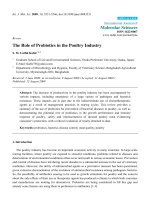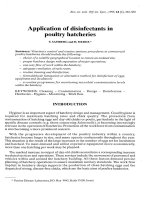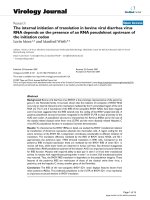Seroprevalence of salmonellosis in bovine herds
Bạn đang xem bản rút gọn của tài liệu. Xem và tải ngay bản đầy đủ của tài liệu tại đây (217.15 KB, 6 trang )
Int.J.Curr.Microbiol.App.Sci (2019) 8(10): 473-478
International Journal of Current Microbiology and Applied Sciences
ISSN: 2319-7706 Volume 8 Number 10 (2019)
Journal homepage:
Original Research Article
/>
Seroprevalence of Salmonellosis in Bovine Herds
R. Nethra1*, P. T. Ramesh2, B. M. Veeregowda3,
C. Ansar Kamran1, A. Muralidhara4 and M. L. Sathyanarayana5
1
Department of Veterinary Medicine, Veterinary College, Hebbal, Bengaluru, India
2
Peripheral Veterinary Hospital, Yelahanka, Bengaluru, India
3
IAH & VB, Bengaluru, India
4
Department of VCC, Veterinary College, Hebbal, Bengaluru, India
5
Department of Veterinary Pathology, Veterinary College, Hebbal, Bengaluru, India
*Corresponding author
ABSTRACT
Keywords
Bovine, Rapid Plate
test, Salmonellosis,
Seroprevalence
Article Info
Accepted:
07 September 2019
Available Online:
10 October 2019
Rapid plate test was performed in five different bovine herds at Yenigadale,
Ganjigunte, Gowribidanur, Shidlaghata and Chickaballapur classifying
animals in the herd into aborted animals, diarrheic animals and apparently
healty animals to resolve sero-prevalence of Salmonellosis. The
seroprevalence of Salmonellosis was observed to be 42.5% (17 out of 40),
11.5% (14 out of 122) and 32.8% (148 out of 451) in aborted animals,
diarrhoeic animals and apparently healthy animals respectively from the
613 samples screened. On an overall 29.2% seroprevalence of
Salmonellosis was observed from five herds screened, whereas it was
29.7%. 30.9%, 33.3%, 26.8% and 19.5% in the herds at Yenigadale
(30/101), Ganjigunte (48/155), Gowribidanur (59/177), Shidlaghata (25/93)
and Chickaballapur (17/87), respectively where the seroprevalence reported
was increasing with the herd size.
al., 2004). Dairy cows may serve as
asymptomatic carriers of Salmonella.
Introduction
Bovine salmonellosis is of worldwide public
health concern and is an economically
important disease. Although cattle of all ages
can be infected with salmonella bacteria,
serious infections and deaths are most often
seen in calves of 10 weeks of age (Hume et
The potential herd carrier status increases with
herd size and Salmonella shedding may be
triggered by stresses placed on the animals
(Huston et al., 2002). Traditional laboratory
culture techniques consume long time before
473
Int.J.Curr.Microbiol.App.Sci (2019) 8(10): 473-478
getting a positive or negative result, use of
simple, rapid serological tests like slide
microagglutination test is convenient method
for detecting the prevalence of Salmonella in
animals (Jonsson, 2013).
In the present study, a rapid plate test was
performed to investigate seroprevalence of
Salmonellosis in bovines in different herds in
karnataka.
Materials and Methods
The test was performed by mixing serum (0.02
ml) with Salmonella Typhimurium somatic
antigen (0.02 ml) on a clean slide. The somatic
antigen was prepared as per OIE, 2007 by
harvesting S. Typhimurium on nutrient agar.
The slide was left for 2 minutes, after which
the test was read. The test components were
stored at 4°C and brought to room temperature
before being used.
The slide agglutination test was performed for
612 serum samples collected at Yenigadale,
Ganjigunte, Gowribidanur, Shidlaghata and
Chickaballapur. Amongst these 121 were from
diarrhoeic cases and 491 were from nondiarrhoeic apparently healthy animals.
Results and Discussion
The slide agglutination test was performed for
612 samples collected at Yenigadale,
Ganjigunte, Gowribidanur, Shidlaghata and
Chickaballapur (Fig. 1). Amongst these, 121
were from diarrheic cases and 491 were from
non-diarrheic apparently healthy animals.
The serum samples collected from 121
diarrheic cases were from 32 cattle calves, 20
cattle heifers, 27 lactating cattle, 10 buffalo
calves, 14 buffalo heifers and 18 lactating
buffaloes. On performing rapid plate
agglutination test 18.5 per cent (5 out of 27)
lactating cattle, 16.6 per cent (3 out of 18)
lactating buffaloes, 10 per cent (1 out of 10)
buffalo calves, 9.3 per cent (3 out of 32) cattle
calves, 7.1 per cent (1 out of 14) buffalo
heifers and 5 per cent (1 out of 20) cattle
heifers were seropositive for Salmonella
agglutinins. On an overall 11.6 per cent of
diarrheic animals were seropositive for
Salmonella agglutinins (Table 1).
The serum samples collected from 491 nondiarrheic cases were from 93 cow calves, 75
cattle heifers, 235 lactating cattle, 17 buffalo
calves, 30 buffalo heifers and 41 lactating
buffaloes. On performing rapid plate
agglutination test 45.9 per cent (108 out of
235) lactating cattle, 34.1 per cent (14 out of
41) lactating buffaloes, 29.4 per cent (5 out of
17) buffalo calves, 25.8 per cent (24 out of 93)
cow calves, 10.6 per cent (8 out of 75) cattle
heifers and 10.0 per cent (3 out of 30) buffalo
heifers were seropositive for Salmonella
agglutinins. Overall 32.9 per cent of nondiarrheic animals were seropositive for
Salmonella agglutinins (Table 2).
Association between clinical finding of
diarrhoea and presence of Salmonella
antibody in serum of animal was determined
by using the Chi Square test which was found
to be non significant at 5 % level (P < 0.05) in
bovine serum.
On an overall 29.2 per cent seroprevalence of
Salmonellosis was observed from 613 samples
screened, whereas it was 29.7, 30.9, 33.3, 26.8
and 19.5 per cent in the herds at Yenigadale of
herd size 101, Ganjigunte of herd size 155,
Gowribidanur of herd size 177, Shidlaghata of
herd size 93 and Chickaballapur of f herd size
87, respectively (Table 3) and it was observed
to be 42.5 per cent (17 out of 40), 11.5 per
cent (14 out of 122) and 32.8 per cent (148 out
of 451) in aborted animals, diarrheic animals
and apparently healthy animals respectively.
474
Int.J.Curr.Microbiol.App.Sci (2019) 8(10): 473-478
Table.1 Seroprevalence of Salmonellosis in diarrheic bovine by Rapid plate test.
Animals
Diarrheic cow calves (< 9months age)
Diarrheic heifers
Diarrheic lactating cattle
Diarrheic Buffalo calves
Diarrheic heifers
Diarrheic adult buffalo
Total
32
20
27
10
14
18
121
Positive
3
1
5
1
1
3
14
Negative
29
19
22
9
13
15
107
Positive %
9.3
5.0
18.5
10.0
7.1
16.6
11.6
Table.2 Seroprevalence of Salmonellosis in non diarrheic bovine by Rapid plate test.
Animals
Non diarrheic cow calves (< 9months age)
Non diarrheic heifers
Non diarrheic lactating cattle
Non diarrheic Buffalo calves. (< 9months age)
Non diarrheic heifers
Non diarrheic adult buffalo
Total
93
75
235
17
30
41
491
Positive
24
8
108
5
3
14
162
Negative
69
67
127
12
27
27
329
Positive %
25.8
10.6
45.9
29.4
10.0
34.1
32.9
Fig.1 Serum samples showing positive reaction for the slide agglutination test performed using
whole cell antigen of Salmonella Typhimurium serotype.
Grading of agglutination reaction:
433 serum samples showed no agglutination – Negative
30 serum samples showed barely visible, very small / small agglutinates, opaque background - +
58 serum samples showed many small agglutinates background not completely clear - ++
97 serum samples showed several large agglutinates - +++
475
Int.J.Curr.Microbiol.App.Sci (2019) 8(10): 473-478
Table.3 Herd wise seroprevalence of Salmonellosis
Herd
No.
Aborted
of Positive Prevalence No.
animals
Diarrheic
Apparently healthy
of Positive Prevalence No. of Positive Prevalence No.
(%)
animals
(%)
animals
Total animals
of Positive Prevalence
(%)
animals
(%)
Yenigadale
4
1
25.0
21
1
4.7
76
28
36.8
101
30
29.7
Ganjigunte
12
5
33.3
29
4
13.7
114
39
34.2
155
48
30.9
Gowribidanur
13
7
53.8
36
7
19.4
128
45
35.2
177
59
33.3
Shidlaghata
7
3
42.8
20
1
5.0
66
21
31.8
93
25
26.8
Chickaballapur 4
1
25.0
15
1
6.2
67
15
22.3
86
17
19.5
17
42.5
121
14
11.5
451
148
32.8
612
179
29.2
Total
40
476
Int.J.Curr.Microbiol.App.Sci (2019) 8(10): 473-478
In the present study, the observed
seroprevalence of Salmonellosis from five
bovine herds (29.2%) was in accordance with
Jonsson (2013) and Wolff et al., (2017). The
detection of Salmonella antibodies in large
number of healthy and sick animals is not
surprising because salmonellosis is hyperendemic in India.
Maximal seroprevalence was detected in adult
cattle (18.5%) followed by adult buffalo
(16.6%)
among
diarrhoeic
animals.
Seroprevalence was also detected to be
maximum in non diarrhoeic adult cattle
(45.9%). The results were in accordance with
Singh et al., (2009) and Upadhyay et al.,
(2014).
In our study an appreciably high
seroprevalence was observed in adult animals
as compared to calves. The results observed
were in accordance with Upadhyay et al.,
(2014). In agreement to our findings, Verma et
al., (2008) have also reported high
seroprevalence of Salmonella agglutinins in
dogs with the increasing age, which might be
either due to increase in susceptibility of dogs
with age as in humans or repeated subclinical
infection which increased the antibodies
detected by the test. Adult cows and buffaloes
are more susceptible as compared to young
ones.
On an overall the seroprevalence of
Salmonellosis was 42.5% in aborted animals,
11.5% in diarrhoeic animals and 32.8% in
apparently healthy animals. The findings
indicated that the occurrence of diarrhoea and
Salmonella antibody in serum are not
associated with each other. Diarrhoea in
young calves has a multifactorial etiology and
may be caused by rota virus, corona virus,
Escherichia coli, or Salmonella spp. Screening
of available literature did not reveal any study
conducted on sero prevalence of Salmonella
agglutinin in bovine diarrhoeic animals of
Karnataka.
In the present study, the reported
seroprevalence increased with the herd size.
This observation is in accordance with Huston
et al., (2002). Large herds may have more
intensive
management
practices,
may
introduce more cows, and be more likely to
experience stress attributable to animal
mixing, crowding, and transportation,
compared with smaller herds; however, the
biological mechanism for this increased risk is
unknown. Because infected cows shed the
organism intermittently, the probability of
obtaining a positive test result increases
proportionally to the number of cows tested.
The seroprevalence of salmonellosis in
bovines in Karnataka was found to be high
which is of zoonotic importance and this may
also be a reason in the lower production in the
dairy industry.
References
Hume, M.E., Edrington, T.S., Looper, M.L.,
Callaway, T.R., Genovese, K.J. And
Nisbet, D.J., 2004. Salmonella
genotype diversity in nonlactating and
lactating dairy cows. J. Food Prot.
67(10): 2280-2283.
Huston, C.L., Wittum, T.E., Love, B.C. And
Keen, J.E., 2002. Prevalence of fecal
shedding of Salmonella spp in dairy
herds. JAVMA. 220(5): 645-649.
Jönsson, E., 2013. Seroprevalence and risk
factors
for
bovine
brucellosis,
salmonellosis and bovine viral diarrhea
in urban and peri-urban areas of
Kampala, Uganda. Thesis., Upssala.
Lanzas, C., Warnick, L.D., Ivanek, R.,
Ayscue, P., Nydam, D.V. and Grohn,
Y.T., 2008. Vet. Res. 39: 58-61.
Office International of Epizootic, 2016.
Salmonellosis.
Chapter
2.9.8.
Terrestrial Manual, pp: 1-18.
Sachan, N., Nautiyal, B., Agarwal, R.K.,
Singh, V.P. and Verma, A.K., 2013.
477
Int.J.Curr.Microbiol.App.Sci (2019) 8(10): 473-478
Sero-epidemiological
Pattern
of
Salmonellosis
in
Animals
of
Rohilkhand Region, Uttar Pradesh,
India. J. Anim. Healt. and Prod.1(1):
6-9.
Singh, B. R., J. C. Verma, K. P. Singh and Y.
P. Singh., 2009. Sero-prevalence of
Salmonella infection in animals in
north India. Haryana Vet. 48: 43-46.
Upadhyay, A. K., Swamy, M., Dubey,A. and
Shrivastava, D. P., 2014. Prevalence of
bovine salmonellosis in organized
dairy farms. Indian J. Vet Sci.
Biotechnol., 10(3): 60-62.
Verma, A.K., Sinha, D.K. and Singh, B.R.,
2008.
Micro-Agglutination
Test
(MAT) based sero-epidemiological
study of salmonellosis in dogs. J.
Immunol. and Immunopathology,
10(1): 29-35.
How to cite this article:
Nethra, R., P. T. Ramesh, B. M. Veeregowda, C. Ansar Kamran, A. Muralidhara and
Sathyanarayana, M. L. 2019. Seroprevalence of Salmonellosis in Bovine Herds.
Int.J.Curr.Microbiol.App.Sci. 8(10): 473-478. doi: />
478









